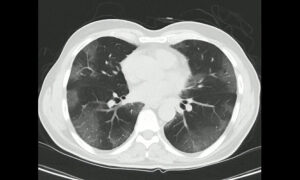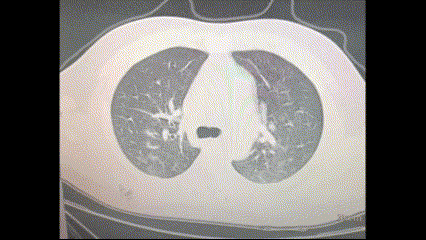‘It Doesn’t Make Sense,’ Experts Trying to Explain White Lungs in China
While the official data from China reports mild disease and low mortalities surrounding the latest COVID-19 outbreaks, Chinese social media is awash with reports of “white lung,” a form of pneumonia often seen in moderate to severe disease. Anecdotal accounts of deaths after infections, and overwhelmed hospitals and morgues, have flooded Weibo and Chinese short-form video platforms. White Lungs: a Telling Sign of Severe Disease Pulmonary critical care specialist Dr. Joseph Varon from Baylor University expressed his perplexity at the white-lung reports on Chinese social media. “It doesn’t make sense,” he said, referring to the official reports from China that state the dominant circulating strains as BA.5.2 and BF.7, both Omicron variants that cause mild disease. Omicron in general, “[doesn’t] give you white lungs,” he argued. “Those images [on social media] suggest that you’re dealing with something very similar to Delta.” Whiteness in Computed Tomography (CT) scans is a telling sign of severe disease. “The whiter the lungs are, the more chances of dying you have,” said Varon, referring to a study he co-authored on disease prognosis. Omicron’s different surface markers make the variant more capable of infecting the upper airways rather than causing inflammation and pneumonia in the lungs. Pneumonia is more likely seen in patients infected with Omicron if they are old and severely immunocompromised. The Epoch Times recently spoke to a 36-year-old man in China, who had no underlying health issues but developed white lungs in mid-December 2022 after developing flu-like symptoms. Feeling like he couldn’t breathe, he admitted himself to the hospital. Doctors did not make a diagnosis but prescribed him Azvudine, a drug conditionally approved in China to treat COVID-19. Pulmonary critical care specialist Dr. Paul Marik said the man’s lungs on the CT scans had typical signs of COVID-19 pneumonia. Varon speculated that if the cases of white lungs were indeed reported in many healthy and younger people, he would question if it were Omicron dealing so much of the damage. Computed Tomography scan of the ground source’s lungs after developing flu-like symptoms in mid-December 2022. The Epoch Times Low and Impaired Immunity From Lockdowns Microbiologist Dr. Stanley Perlman expressed that he was “unsurprised” to see the white-lung reports in China. Perlman argued that the zero-COVID policies and strict lockdown controls meant that most people likely had both low exposure and immunity to the virus, which would increase their chances of developing severe disease. Professor of infectious disease Dr. William Schaffner from Vanderbilt University School of Medicine agreed that the lockdowns have reduced viral exposure and natural immunity. “In China, the lockdown was so rigorous,” said Schaffner. “It really reduced the transmission of COVID.” Schaffner said that while the rest of the world seems to be dealing with Omicron as a mild, background disease, with so little data coming out of China on the death and infection rates, it is difficult to draw a comparison and make a comprehensive assessment of China’s situation. Dr. David Bell, an infectious disease expert and former medical officer at the World Health Organization, criticized China’s lockdown policies for contributing to large outbreaks. Bell argued that it was not new knowledge that lockdowns cannot control a respiratory virus and that such measures can potentially impair people’s immune systems if prolonged. Additionally, children kept in sterile and isolated environments would develop poor immune responses when exposed to environmental stimulants. “I call it the bubble boy,” said Varon. “It’s like if you have a kid. You wouldn’t want the kid to get infected with everything, [but] you want to expose them to normal things. If you keep them in a glass bubble, anything can kill them.” Pulmonary critical care specialist Dr. Paul Marik said that humans would naturally mingle once the restrictions were lifted, and naturally start spreading the virus. “This [the increase in cases and deaths] was going to happen. It was just when it happened,” said Marik. A health worker waits for people to take swab samples to test for COVID-19 in Shanghai, China, on Dec. 19, 2022. Hector Retamal/AFP via Getty Images Rebuttal to the Lockdown Argument Virologist Dr. Li-Meng Yan was more dismissive of the argument that the white-lung presentation was from a lack of general immunity due to zero-COVID measures. Yan said this reasoning would assume that few people were infected in the earlier outbreaks in China, but this is unverifiable. Since COVID-19 emerged in China in 2019, all of the data on infection and mortality rates have come from China’s official reports and no outside research group has been able to verify the numbers independently. Yan, who studied the COVID-19 virus at the University of Hong Kong early in the pandemic, said that the sharing o

While the official data from China reports mild disease and low mortalities surrounding the latest COVID-19 outbreaks, Chinese social media is awash with reports of “white lung,” a form of pneumonia often seen in moderate to severe disease.
Anecdotal accounts of deaths after infections, and overwhelmed hospitals and morgues, have flooded Weibo and Chinese short-form video platforms.
White Lungs: a Telling Sign of Severe Disease
Pulmonary critical care specialist Dr. Joseph Varon from Baylor University expressed his perplexity at the white-lung reports on Chinese social media.
“It doesn’t make sense,” he said, referring to the official reports from China that state the dominant circulating strains as BA.5.2 and BF.7, both Omicron variants that cause mild disease.
Omicron in general, “[doesn’t] give you white lungs,” he argued. “Those images [on social media] suggest that you’re dealing with something very similar to Delta.”
Whiteness in Computed Tomography (CT) scans is a telling sign of severe disease. “The whiter the lungs are, the more chances of dying you have,” said Varon, referring to a study he co-authored on disease prognosis.
Omicron’s different surface markers make the variant more capable of infecting the upper airways rather than causing inflammation and pneumonia in the lungs. Pneumonia is more likely seen in patients infected with Omicron if they are old and severely immunocompromised.
The Epoch Times recently spoke to a 36-year-old man in China, who had no underlying health issues but developed white lungs in mid-December 2022 after developing flu-like symptoms.
Feeling like he couldn’t breathe, he admitted himself to the hospital. Doctors did not make a diagnosis but prescribed him Azvudine, a drug conditionally approved in China to treat COVID-19.
Pulmonary critical care specialist Dr. Paul Marik said the man’s lungs on the CT scans had typical signs of COVID-19 pneumonia.
Varon speculated that if the cases of white lungs were indeed reported in many healthy and younger people, he would question if it were Omicron dealing so much of the damage.

Low and Impaired Immunity From Lockdowns
Microbiologist Dr. Stanley Perlman expressed that he was “unsurprised” to see the white-lung reports in China.
Perlman argued that the zero-COVID policies and strict lockdown controls meant that most people likely had both low exposure and immunity to the virus, which would increase their chances of developing severe disease.
Professor of infectious disease Dr. William Schaffner from Vanderbilt University School of Medicine agreed that the lockdowns have reduced viral exposure and natural immunity.
“In China, the lockdown was so rigorous,” said Schaffner. “It really reduced the transmission of COVID.”
Schaffner said that while the rest of the world seems to be dealing with Omicron as a mild, background disease, with so little data coming out of China on the death and infection rates, it is difficult to draw a comparison and make a comprehensive assessment of China’s situation.
Dr. David Bell, an infectious disease expert and former medical officer at the World Health Organization, criticized China’s lockdown policies for contributing to large outbreaks.
Bell argued that it was not new knowledge that lockdowns cannot control a respiratory virus and that such measures can potentially impair people’s immune systems if prolonged.
Additionally, children kept in sterile and isolated environments would develop poor immune responses when exposed to environmental stimulants.
“I call it the bubble boy,” said Varon. “It’s like if you have a kid. You wouldn’t want the kid to get infected with everything, [but] you want to expose them to normal things. If you keep them in a glass bubble, anything can kill them.”
Pulmonary critical care specialist Dr. Paul Marik said that humans would naturally mingle once the restrictions were lifted, and naturally start spreading the virus.
“This [the increase in cases and deaths] was going to happen. It was just when it happened,” said Marik.
-

Rebuttal to the Lockdown Argument
Virologist Dr. Li-Meng Yan was more dismissive of the argument that the white-lung presentation was from a lack of general immunity due to zero-COVID measures.
Yan said this reasoning would assume that few people were infected in the earlier outbreaks in China, but this is unverifiable.
Since COVID-19 emerged in China in 2019, all of the data on infection and mortality rates have come from China’s official reports and no outside research group has been able to verify the numbers independently.
Yan, who studied the COVID-19 virus at the University of Hong Kong early in the pandemic, said that the sharing of data between mainland Chinese and Hong Kong research laboratories suddenly became controlled and scrutinized. Scientists in Hong Kong could only work with official data and make their own estimations.
Interviews conducted with Chinese citizens during the early outbreaks also showed that in the very first Wuhan outbreak, case numbers and deaths were underreported as hospitals turned away people presenting with COVID-19 symptoms.
Yan argued that it was likely that the earlier outbreaks were more severe than what was officially reported. By this, Yan means that if more people had been infected and died, then more should now also have some degree of immunity that protects them against the Omicron variant.
Yet cities like Wuhan and Changsha, both of which were COVID-19 hotspots in earlier outbreaks, are now seeing a repeat of the overload in hospitals and morgues.
The problem with China’s new outbreak is just the same as the first outbreak three years ago: The data is unverified and likely underreporting the real mortality and infection rates.
While the lifting of the zero-COVID policies would have contributed to further spread, Yan argued that the strict lockdowns were not consistent.
She pointed to media reports of lockdowns in Shanghai and Xinjiang, which lasted for months and left many people starved. Yan said that while those lockdowns were severe and the experiences real, the reality was that most of the zero-COVID policies were about contact tracing and implementing “digital control using tracking codes.”
Once lockdowns were lifted, business went on as usual; people would work and go outside for daily testing, which put them in an environment of viral exposure.
According to WHO data, over 86 percent of China’s population has taken the two primary shots of the Chinese COVID vaccines, and around 55 percent has been boosted.
Given these exposures, Yan argues that most people have some level of immunity.
In light of these inconsistencies, Yan said that global health agencies should ask why Chinese health authorities stopped PCR testing to track new variants.
Schaffner also expressed concern that the variants are not being tracked.
With so many people infected, there is “a certain anxiety” among biologists and public-health authorities, said Schaffner, “that this is an environment where potentially a new variant could occur that might evade the protection of our vaccines and therapeutic agents.”












